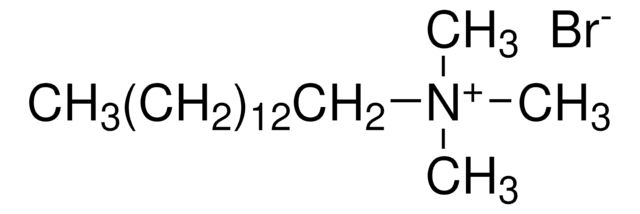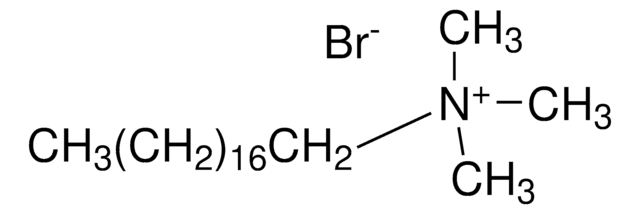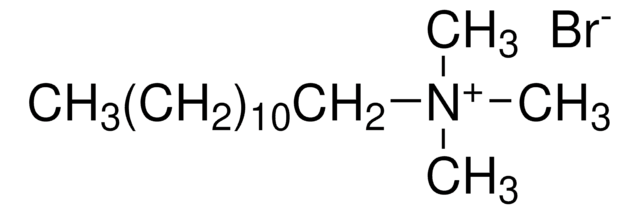Key Documents
87210
Myristyltrimethylammonium bromide
98% (AT)
Synonim(y):
Tetradecyltrimethylammonium bromide, Trimethyl(tetradecyl)ammonium bromide
About This Item
Polecane produkty
opis
cationic
Poziom jakości
Próba
≥97.5% (AT)
98% (AT)
Postać
crystals
masa cząsteczkowa
micellar avg mol wt 27,000
liczba agregacji
80
CMC
4-5 mM (20-25°C)
mp
245-250 °C (lit.)
rozpuszczalność
H2O: 0.1 g/mL, clear
ciąg SMILES
[Br-].CCCCCCCCCCCCCC[N+](C)(C)C
InChI
1S/C17H38N.BrH/c1-5-6-7-8-9-10-11-12-13-14-15-16-17-18(2,3)4;/h5-17H2,1-4H3;1H/q+1;/p-1
Klucz InChI
CXRFDZFCGOPDTD-UHFFFAOYSA-M
Szukasz podobnych produktów? Odwiedź Przewodnik dotyczący porównywania produktów
Opis ogólny
Zastosowanie
- Enhance the biomass harvesting and pigments extraction from the cyanobacterium Synechocystis sp. PCC 6803.
- Facilitate the formation of mixed micelles with amitriptyline hydrochloride.
Hasło ostrzegawcze
Danger
Zwroty wskazujące rodzaj zagrożenia
Zwroty wskazujące środki ostrożności
Klasyfikacja zagrożeń
Acute Tox. 4 Oral - Aquatic Acute 1 - Aquatic Chronic 1 - Eye Dam. 1 - Skin Irrit. 2 - STOT RE 2 Oral - STOT SE 3
Organy docelowe
Gastrointestinal tract, Respiratory system
Kod klasy składowania
11 - Combustible Solids
Klasa zagrożenia wodnego (WGK)
WGK 3
Temperatura zapłonu (°F)
Not applicable
Temperatura zapłonu (°C)
Not applicable
Środki ochrony indywidualnej
Eyeshields, Faceshields, Gloves, type P3 (EN 143) respirator cartridges
Wybierz jedną z najnowszych wersji:
Masz już ten produkt?
Dokumenty związane z niedawno zakupionymi produktami zostały zamieszczone w Bibliotece dokumentów.
Klienci oglądali również te produkty
Nasz zespół naukowców ma doświadczenie we wszystkich obszarach badań, w tym w naukach przyrodniczych, materiałoznawstwie, syntezie chemicznej, chromatografii, analityce i wielu innych dziedzinach.
Skontaktuj się z zespołem ds. pomocy technicznej














